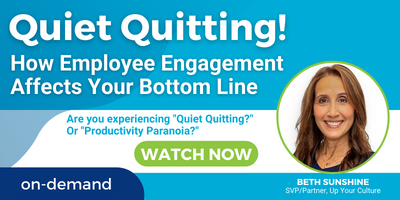
Take a moment to imagine you’ve invited your employees to an annual company campfire. Once they’ve arrived, they disperse into three groups based on their level of commitment to building and maintaining the fire.
These three groups are engaged employees, non-engaged employees, and actively disengaged employees.
Engaged, Non-Engaged, and Actively Disengaged Employees
- The engaged group is going to get started right away. They’ll gather kindling, rub sticks together to create a spark, and once the fire’s roaring, they will continue to add logs and keep the momentum going. This group is dedicated to working towards a common vision. They have deepened relationships, lending themselves to teamwork, and they believe they can make a difference.
Engaged employees come from a strong company culture that outlines a clear Reason for Being and exemplifies its Core Values. This group can leverage their passion and motivation to convince others to join the charge. They need to be the majority. As a leader, your role in this group involves the most manual labor but will have the largest impact in the end.
- The non-engaged group will “pull up a log” and sit around the campfire, conversing with one another and taking advantage of the heat the fire is putting off. Are they really hurting anything?
No, not really. Are they really helping anything along? No, not really. They’re observing, not participating, but this group has the highest potential to get involved.
- The actively disengaged employees are bringing buckets of water over and dumping them on your campfire while simultaneously tossing the logs from your stockpile back into the woods. They were probably disinterested in attending in the first place and tried to convince others to skip the event altogether. If you tried to speak to kick off the event, they likely spoke over you.
When the campfire dwindles, everyone around it is impacted. It’s difficult for your engaged group to gain any ground if your actively disengaged employees are working to destroy the vision. So, what happens when you’re engaged employees become exhausted from all of their efforts? They simply start caring less.
Quiet Quitting - Re-Engaging the Engaged
The term “quiet quitting” refers to employees who used to invest themselves in their companies but have now scaled back on their investments. These employees are former members of the engaged group. Instead of tending to the fire, they’ve put their logs down and taken a seat to join the non-engaged group. Quite frankly, they’re exhausted! Now, they’re making minimal effort to meet the minimum requirements. These used to be your key players.
So how do we flip the narrative back in the right direction and re-engage the engaged? Here are two small steps that can be very effective.
- Start by carrying the log over to them, so they simply need to lay it across the fire. In the workplace, this means encouraging regular breaks throughout the workday and providing frequent acknowledgment for their efforts. It can be easy to get distracted by those ruining your campfire and forget about those trying to help. Incorporate touch base meetings often and be sure to ask them: How can I support you?
- After you’ve taken the first step, identify what your employees are most interested in. Maybe they would prefer to stoke the fire rather than carry logs over or stack them in the fire ring. To translate this into the workplace, assign and delegate work based on interests, talents, and strengths. Science proves that those involved in activities leveraging talents feel more fulfilled at the end of the work day. Not only that but quality and productivity increase as well.










Leave a Comment